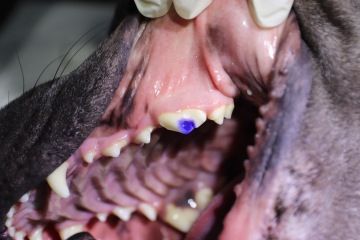Treatment of tooth fracture
2 years ago

How can a dog break a tooth?
Compared to tooth decay, broken teeth are quite common in dogs. They can result from external trauma (such as being hit by a car or object) or from chewing on hard objects such as antlers, bones or other hard, non-bending chew toys. The most commonly broken teeth in a dog are canines (fangs) and canine complex teeth (large teeth in the back of the mouth).
What does a broken tooth look like?
Sometimes a broken tooth is missing only a piece of enamel (the hard mineralized surface of the teeth) and dentin (the white-yellow tissue under the enamel), and other times the tooth is broken in such a way that the marrow or pulp (the soft tissue inside the tooth composed of nerve tissue, blood cells) is also "outside" blood vessels and lymphatic tissue).
There are six types of tooth fractures in dogs:
Enamel fracture - a fracture with loss of crown mass limited to the enamel
Uncomplicated crown fracture - a crown fracture that does not expose the pulp
Complicated crown fracture - a crown fracture that exposes the pulp.
Uncomplicated crown and root fracture - a crown and root fracture that does not expose the pulp
Complicated crown and root fracture - a crown and root fracture that exposes the pulp
Root fracture - a fracture involving the root of the tooth.
Is a broken tooth in a dog a problem?
Yes, broken teeth in dogs are a problem. When the enamel is chipped away and the dentin is exposed, the affected tooth becomes sensitive to heat, cold and pressure. It is far worse when the pulp (the soft part of the tooth that contains blood vessels and nerves) is exposed - a complicated fracture (see classification above). The inside of the tooth fills with infected material, which can eventually pass through the tip of the root into the jaw. Since the bacteria have a "safe haven" inside the root canal, the body's immune system is unable to clear the infection, even with antibiotic treatment. Infection that has spread to the periapical area (the bone surrounding the tip of the root) causes pain every time the dog chews and can be a source of infection in other parts of the body.
What are the symptoms of a broken tooth?
Chewing on one side
Food falling out of the mouth while eating
Excessive drooling
Scratching the muzzle on the floor/carpet, or scratching the muzzle excessively with a paw
Swelling of the face
Enlargement of lymph nodes
By refusing to stroke the face
Refusal to eat solid food
Refusal to chew hard treats or toys
It should not be forgotten that these symptoms can also indicate other dental problems such as periodontal disease, tooth decay, inflammation, a foreign body in the mouth, an oncological problem and others.
What can be done to repair a broken tooth?
Most fractures need to be treated. If the pulp cavity is exposed/open, there are usually three options for treating a broken tooth:
root canal therapy - endodontics
vital amputation of the pulp - in young animals under 18 months where the tooth root has not yet fully developed
extraction
If the pulp is not open, the tooth can be restored without root canal therapy. Ignoring the problem is not a good option because the tooth will be sensitive and painful.
Root canal treatment involves removing the diseased tissue inside. As with humans, an x-ray of the tooth is needed to evaluate the surrounding tissues and check that the root is intact. If a root fracture occurs, the tooth is practically unsalvageable and must be extracted. Instruments are used to clean, disinfect and fill the root canal to prevent future bacterial contamination and save the tooth. The long-term results of root canal treatment are generally excellent.
Vital amputation of the pulp is performed in dogs younger than 18 months. This treatment will ensure the vitality of the tooth and the complete development of the tip of the root with its closure. Subsequently, after the root tip development is complete, endodontic treatment should be performed. In a vital pulp amputation, the pulp layer is removed and the surface bacteria and inflamed tissue are removed. A medicinal insert (calcium hydroxide) is applied to the newly exposed pulp, which enables healing and the creation of a natural dentine bridge and thus the closure of the pulp cavity. Subsequently, the upper part of the tooth is treated as in the treatment of tooth decay - a composite (filling) is applied. Teeth treated with vital pulp therapy may require root canal treatment in the future.
Tooth extraction is another treatment option for a broken tooth. Although this is a cheaper option, on the other hand, the pet remains a functional tooth in its mouth. In our clinic, we try to avoid extracting broken but otherwise healthy teeth and save them if possible. For large canines and chewing teeth, the removal procedure involves oral surgery, comparable to the removal of impacted wisdom teeth in human patients.
How I can prevent my dog from breaking more teeth?
Check your dog's treats and toys. Eliminate toys that don't bend easily. Do not use bones, antlers, cow hooves as treats.




